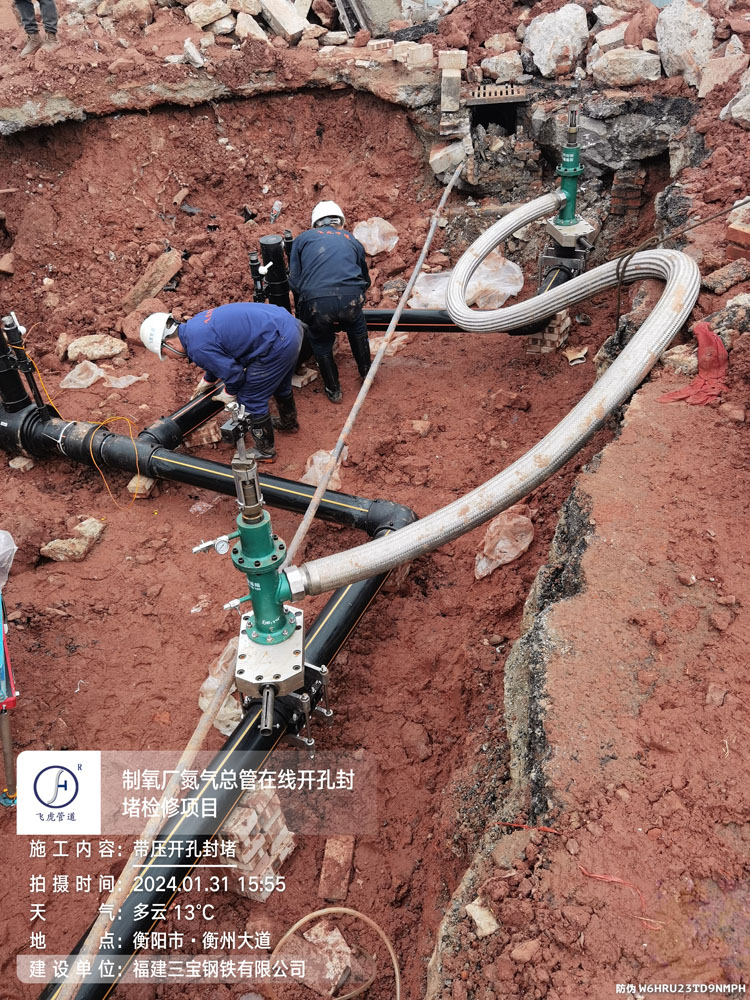Understanding PE Line Stopping Services for HDPE Pipelines
PE Line Stopping Services for HDPE Pipelines are a vital solution for industries that depend on uninterrupted pipeline operations. High-density polyethylene (HDPE) pipelines are widely used in gas distribution, water systems, and industrial facilities due to their durability, resistance to corrosion, and ability to withstand high pressures. However, like all infrastructure, these pipelines require routine maintenance, upgrades, or emergency repairs. Shutting down an entire system can be costly, disruptive, and risky, which is why PE line stopping services are essential. By temporarily isolating a section of the pipeline with a mechanical stopper, technicians can safely perform the necessary work while keeping the rest of the system fully operational. This method not only saves time but also ensures that service delivery remains unaffected. As industries continue to demand reliability and efficiency, PE line stopping has become a cornerstone in HDPE pipeline maintenance practices.
How PE Line Stopping Services Operate in HDPE Pipelines
The operation of PE Line Stopping Services for HDPE Pipelines follows a precise, step-by-step process designed for maximum safety and efficiency. First, the pipeline is carefully assessed to determine the best location for isolation, taking into account factors such as size, material thickness, and internal pressure. Once the assessment is complete, specialized equipment is installed to allow the insertion of a stopper into the pipeline. The mechanical stopper creates a temporary block that halts flow in the targeted section, allowing technicians to carry out maintenance or repairs without shutting down the entire system. Throughout the process, flow is carefully monitored to prevent sudden pressure fluctuations that could compromise safety. Once the necessary work is complete, the stopper is removed, and the system is restored to full service. This structured approach ensures minimal disruption while protecting the integrity of the pipeline system. By following these procedures, PE line stopping services have earned a reputation for being one of the safest and most reliable methods of live pipeline maintenance.
Advantages of PE Line Stopping Services for HDPE Pipelines
The benefits of PE Line Stopping Services for HDPE Pipelines extend well beyond preventing downtime. One of the most significant advantages is operational efficiency, as pipelines remain active while work is performed on isolated sections. This ensures continuity for industries and communities that depend on constant supply. Another major benefit is cost savings, since shutting down pipelines requires time-consuming depressurization, restarting, and potential production loss. Safety improvements are also critical, as line stopping minimizes risks such as leaks, spills, or environmental exposure. By focusing only on the specific area that requires maintenance, this method also contributes to infrastructure protection, ensuring that the broader system remains undisturbed and secure. Versatility is another key factor, as PE line stopping services can be adapted for various pipeline sizes, pressures, and applications across multiple industries. Together, these advantages make PE line stopping one of the most effective and future-ready maintenance solutions for HDPE pipelines.
Safety Measures in PE Line Stopping Services
Safety is the top priority in all PE Line Stopping Services for HDPE Pipelines. Technicians performing this service are trained extensively to handle the complexities of working with live, high-pressure pipelines. Specialized equipment undergoes rigorous testing to ensure it can withstand operational demands without failure. Safety protocols such as continuous monitoring of pressure levels, leak detection, and emergency response measures are always in place. Compliance with strict industry regulations ensures that every project is executed according to the highest safety and environmental standards. Pre-service inspections are conducted to identify potential risks, while post-service checks confirm that pipelines have been restored safely to full operation. Environmental safeguards are also implemented to minimize the risk of contamination during and after the process. By following these measures, PE line stopping services provide a safe, controlled, and reliable solution for maintaining HDPE pipelines without compromising safety or operational continuity.
Industrial Applications of PE Line Stopping Services for HDPE Pipelines
PE Line Stopping Services for HDPE Pipelines are applied across a wide range of industries where uninterrupted service is non-negotiable. In natural gas distribution networks, they allow utility companies to conduct upgrades and emergency repairs without cutting supply to homes and businesses. The oil and fuel transportation sector also benefits significantly, as operations can continue while repairs or modifications are carried out. Municipal water utilities rely on PE line stopping to maintain pipelines and implement improvements without disrupting water access for entire communities. In industrial facilities, such as manufacturing plants, the process prevents costly downtime that could halt production lines. Emergency repair scenarios highlight the importance of this method, as PE line stopping enables rapid isolation of affected sections to prevent larger issues. The adaptability of the process across different applications underscores its importance in modern infrastructure management. No matter the industry, PE line stopping services deliver continuity, safety, and efficiency.
Selecting the Right Provider for PE Line Stopping Services
Choosing the right provider for PE Line Stopping Services for HDPE Pipelines is critical to ensuring successful outcomes. Experienced providers bring proven expertise, allowing them to adapt the process to different pipeline conditions and challenges. Certified technicians with deep knowledge of HDPE systems ensure that projects are carried out safely and efficiently. Providers equipped with advanced, state-of-the-art equipment are able to deliver more precise and reliable results. Beyond technical capabilities, a reliable provider offers long-term value through consistent service, ongoing support, and maintenance planning. Partnering with a trusted company also ensures compliance with safety regulations and industry standards, reducing risks of liability and system failures. When selecting a provider, companies should consider factors such as experience, reputation, safety track record, and investment in technology. By making the right choice, businesses can ensure safe, efficient, and cost-effective pipeline maintenance through professional PE line stopping services.
The Future of PE Line Stopping Services in HDPE Pipeline Maintenance
The future of PE Line Stopping Services for HDPE Pipelines is shaped by innovation, technology, and sustainability. New equipment designs are improving efficiency, making the process faster and safer than ever before. Automation is increasingly being integrated, reducing the need for manual intervention and lowering the risk of human error. Digital monitoring systems now allow technicians to track flow, pressure, and safety indicators in real time, ensuring greater precision throughout the process. As industries place more emphasis on environmental responsibility, PE line stopping services are evolving to include eco-friendly practices that minimize emissions and reduce waste. Emerging trends also highlight the role of advanced materials that enhance the strength and adaptability of stoppers used in high-pressure environments. By embracing these innovations, PE line stopping services are expected to become even more reliable, cost-effective, and sustainable. This continued evolution ensures that the method remains at the forefront of HDPE pipeline maintenance solutions.
Frequently Asked Questions (FAQ)
1. What are PE line stopping services for HDPE pipelines?
They are specialized maintenance services that temporarily stop the flow within HDPE pipelines using mechanical stoppers, allowing work to be performed without shutting down the entire system.
2. How do these services differ from traditional pipeline maintenance methods?
Unlike traditional methods that require full system shutdowns, PE line stopping isolates a section of the pipeline while keeping the rest of the system operational.
3. Are PE line stopping services safe for high-pressure HDPE pipelines?
Yes, when carried out by trained professionals using specialized equipment, the process is safe and effective for high-pressure HDPE pipelines.
4. How long does the line stopping process typically take?
The duration depends on pipeline conditions and the scope of work, but it is generally much faster and less disruptive than full system shutdowns.
5. Which industries benefit the most from these services?
Industries such as natural gas distribution, oil and fuel transport, municipal water utilities, and industrial facilities benefit significantly from PE line stopping services.








